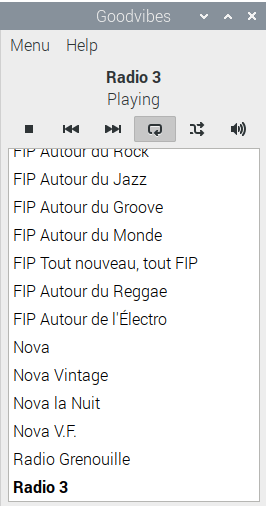Last Updated on May 27, 2020
Goodvibes

Goodvibes is billed as a lightweight internet radio player offering a simple way to access your favourite radio stations.
The interface is very simple. The interface displays the streaming station, and what’s playing (if that information is available, as some stations don’t embed tags in the audio stream). There’s no menu bar, and no preferences to configure in the interface.
Below the stream information, there’s the standard play/stop buttons, channel switching, shuffle, repeat, and a volume slider.
Under the button bar, there’s the channel list. 13 stations populate the default station list — these are French stations.
Managing the station list is a little unusual, as there’s no menu bar. You need to right mouse click on a station. You’ll get a drop down list where you can add a station, delete a station, or edit the selected station’s name and URI. Sadly, there’s no ability to browse radio stations in any shape or form.
It’s possible to compile Goodvibes without a GUI, and control it with its command-line client. This is accessed with the goodvibes-client executable.
If you love experimenting with new radio stations, you’d better go with a player that makes it easy to browse stations e.g. support for the radio-browser open source directory. But if you only listen to a few stations, it’s not too painful to manually feed in the URIs to the interface.
Installation
There’s a Raspbian package, installed with the command:
This gets version 0.4.2. This isn’t the latest version. I attempted to compile the latest release.
I first needed to install a few packages.
Then I cloned the project’s repository, and used meson and ninja to try to build and install the software. Meson is like CMake in that it does not build software directly, but rather sets up a backend build system such as ninja.
$ cd goodvibes
$ meson build
$ ninja -C build
$ sudo ninja -C build install
The ninja command failed to complete.
Next page: Page 8 – Sayonara Player
Pages in this article:
Page 1 – Introduction
Page 2 – Tauon Music Box
Page 3 – Radiotray-NG
Page 4 – PyRadio
Page 5 – StreamTuner2
Page 6 – Curseradio
Page 7 – Goodvibes
Page 8 – Sayonara Player
Page 9 – Cantata
Page 10 – Yarock
Page 11 – Summary
Complete list of articles in this series:
| Raspberry Pi 4 Blog | |
|---|---|
| Week 36 | Manage your personal collections on the RPI4 |
| Week 35 | Survey of terminal emulators |
| Week 34 | Search the desktop with the latest version of Recoll |
| Week 33 | Personal Information Managers on the RPI4 |
| Week 32 | Keep a diary with the RPI4 |
| Week 31 | Process complex mathematical functions, plot 2D and 3D graphs with calculators |
| Week 30 | Internet radio on this tiny computer. A detailed survey of open source software |
| Week 29 | Professionally manage your photo collection with digiKam |
| Week 28 | Typeset beautifully with LyX |
| Week 27 | Software that teaches young people how to learn basic computing skills and beyond |
| Week 26 | Firefox revisited - Raspbian now offers a real alternative to Chromium |
| Week 25 | Turn the Raspberry Pi 4 into a low power writing machine |
| Week 24 | Keep the kids learning and having fun |
| Week 23 | Lots of choices to view images |
| Week 22 | Listening to podcasts on the RPI4 |
| Week 21 | File management on the RPI4 |
| Week 20 | Open Broadcaster Software (OBS Studio) on the RPI4 |
| Week 19 | Keep up-to-date with these news aggregators |
| Week 18 | Web Browsers Again: Firefox |
| Week 17 | Retro gaming on the RPI4 |
| Week 16 | Screen capturing with the RPI4 |
| Week 15 | Emulate the Amiga, ZX Spectrum, and the Atari ST on the RPI4 |
| Week 14 | Choose the right model of the RPI4 for your desktop needs |
| Week 13 | Using the RPI4 as a screencaster |
| Week 12 | Have fun reading comics on the RPI4 with YACReader, MComix, and more |
| Week 11 | Turn the RPI4 into a complete home theater |
| Week 10 | Watching locally stored video with VLC, OMXPlayer, and others |
| Week 9 | PDF viewing on the RPI4 |
| Week 8 | Access the RPI4 remotely running GUI apps |
| Week 7 | e-book tools are put under the microscope |
| Week 6 | The office suite is the archetypal business software. LibreOffice is tested |
| Week 5 | Managing your email box with the RPI4 |
| Week 4 | Web surfing on the RPI4 looking at Chromium, Vivaldi, Firefox, and Midori |
| Week 3 | Video streaming with Chromium & omxplayerGUI as well as streamlink |
| Week 2 | A survey of open source music players on the RPI4 including Tauon Music Box |
| Week 1 | An introduction to the world of the RPI4 looking at musikcube and PiPackages |

I had to also perform the following before cmake would do its thing:
sudo apt install libqt5x11extras5-dev
sudo apt-get install qttools5-dev
sudo apt install libtag1-dev
I probably had these development packages already installed. One thing worth remembering is you don’t need to install packages one-by-one. For example with your commands, you can type:
$ sudo apt install libqt5x11extras5-dev qttools5-dev libtag1-dev
I also had to install the following packages to get this work:
sudo apt install qt5-default qttools5-dev qttools5-dev-tools qtmultimedia5-dev libqt5svg5-dev libqt5webkit5-dev